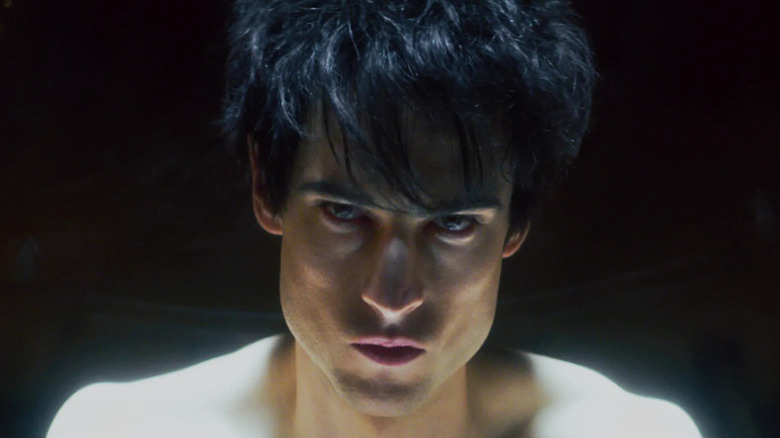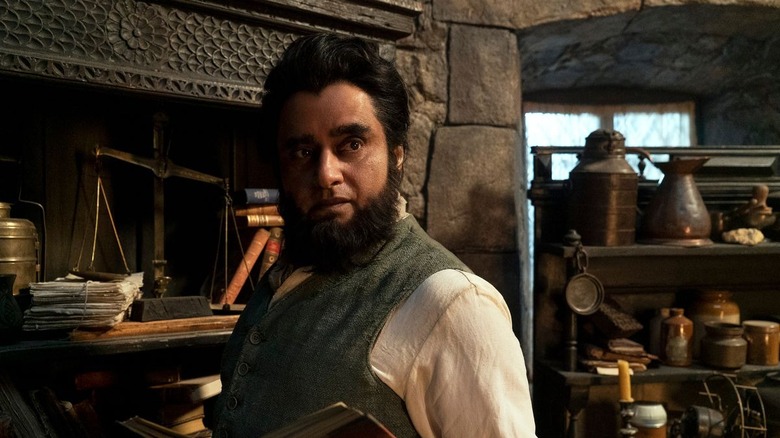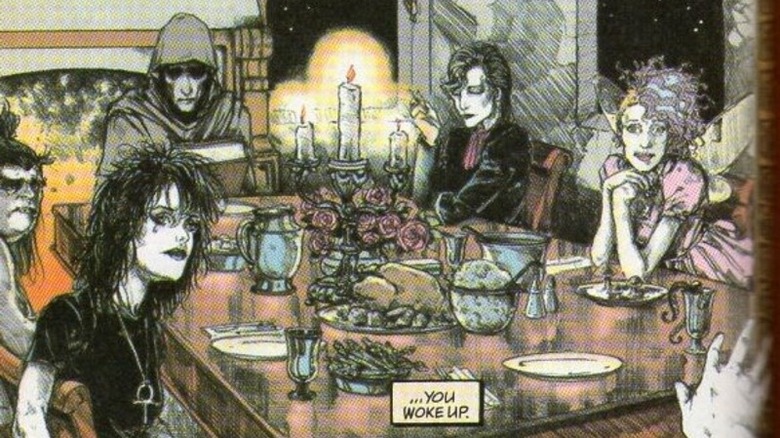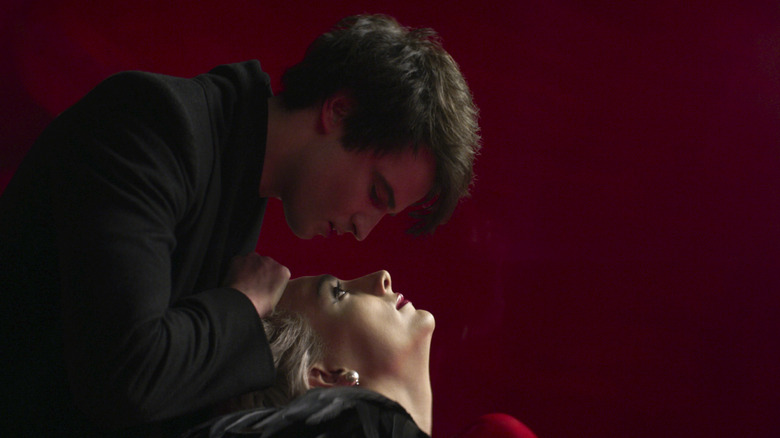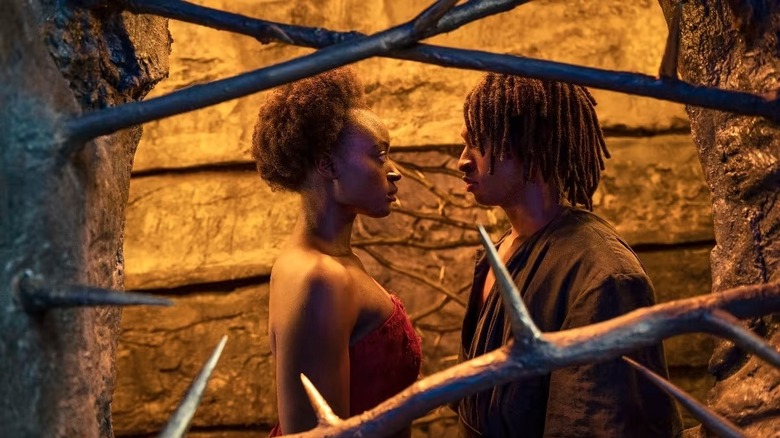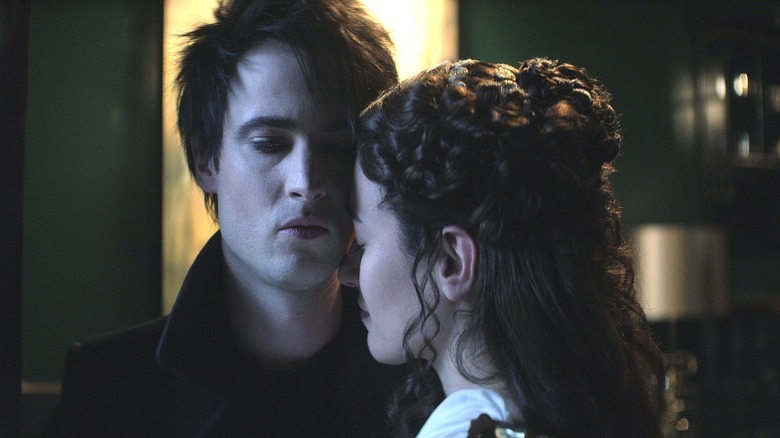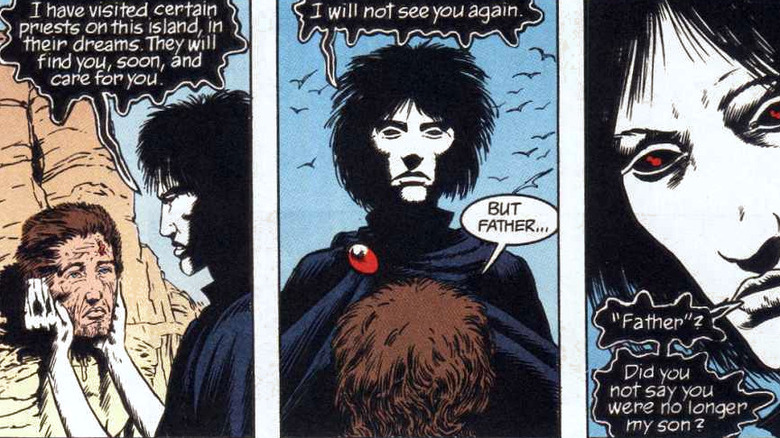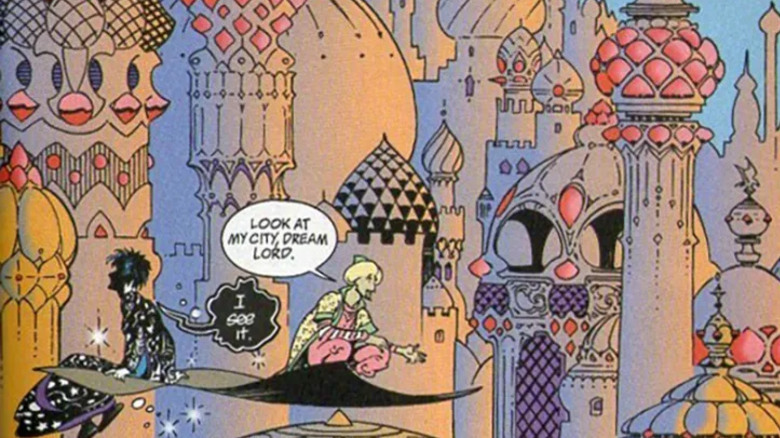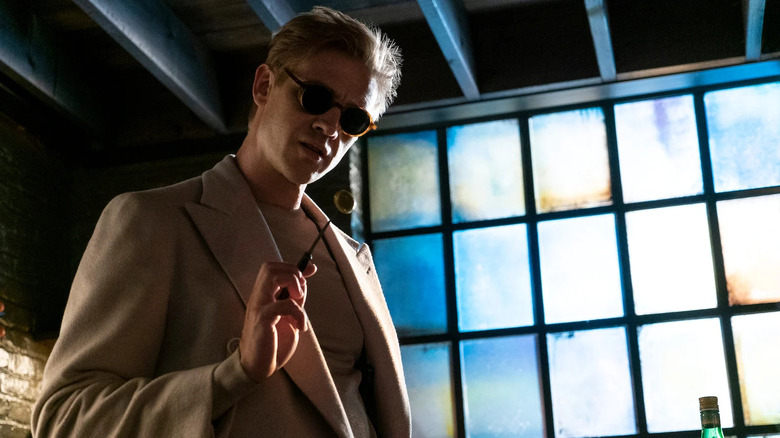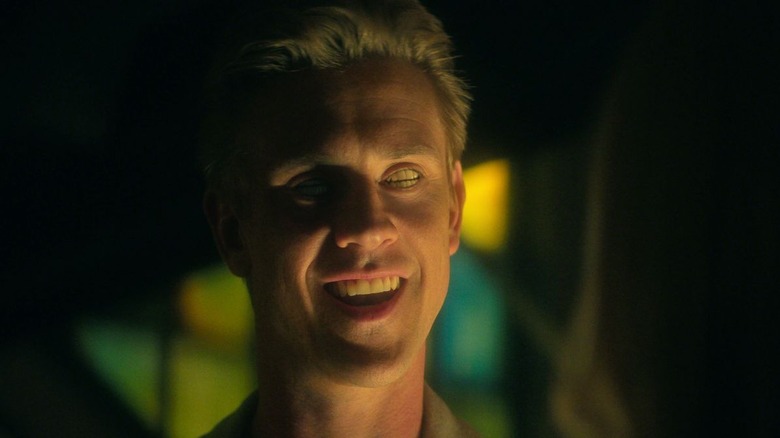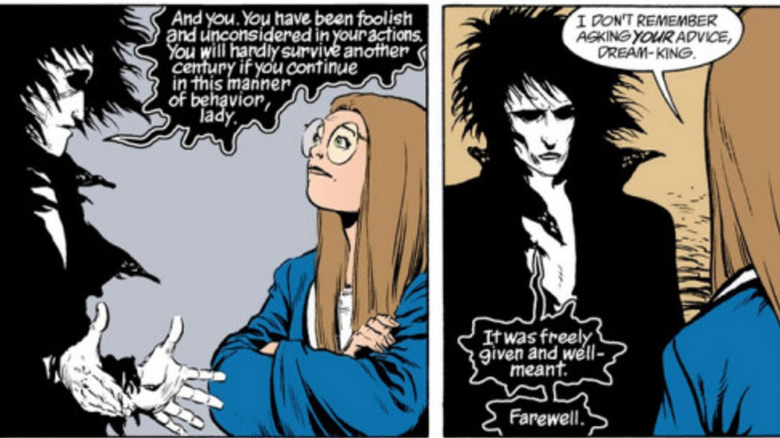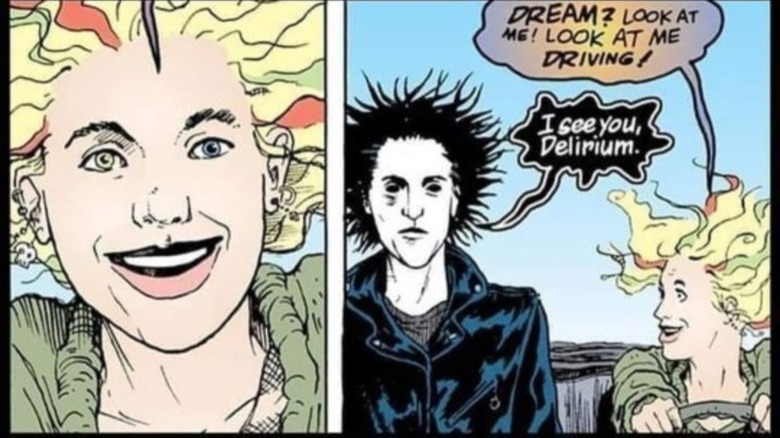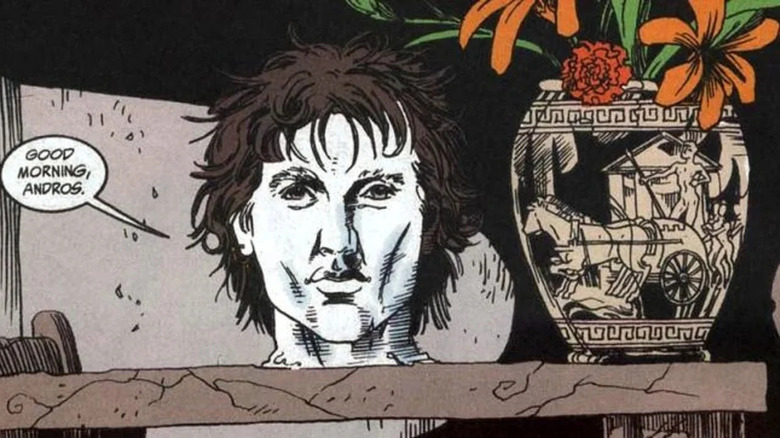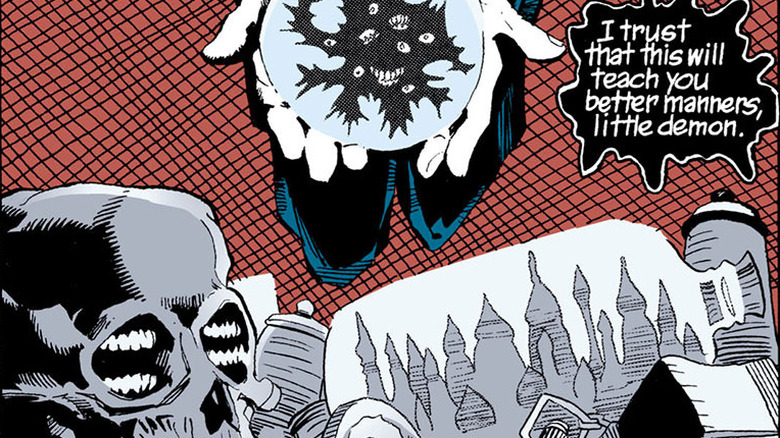The Dark History Of The Sandman
One of the most universally acclaimed and highly influential comic book series of all time is "The Sandman," created by Neil Gaiman, Sam Kieth, and Mike Dringenberg in 1989. Published by DC Comics, the dark fantasy series featured ambitious world-building and incorporated groundbreakingly mature subject matter for a mainstream publisher within the comic book medium. Inspiring a line of spinoffs and earning a growing fanbase, "The Sandman" has since been adapted into a well-received television series produced by Netflix, with Gaiman as a writer and executive producer.
"The Sandman" follows the tale of Morpheus, the living embodiment of Dreams, within a group of mythical beings known simply as the Endless, linked tangentially to the DC Universe. The Endless personify aspects of sentient life, including Death, Desire, and Delirium, as they navigate their complicated relationships with each other and humanity across millennia. Though Morpheus is the seemingly noble protagonist of Gaiman's story, here's a look at the darker elements of the character's history and inspirations across the sweeping fantasy story.
One of Morpheus' servants is humanity's original murderer
Morpheus' domain is an extradimensional realm known as the Dreaming, where his vast kingdom is maintained by figures from reality and dreams. Among the installations within the Dreaming are the Houses of Mystery and Secrets, cared for by the Biblical siblings Cain and Abel. Introduced in "The Sandman" #2, Cain has a nasty habit of violently murdering his brother whenever he is overcome by regular bouts of rage, unable to contain his lethal impulses.
Abel's untimely demise only proves temporary inside of the Dreaming, with the Judeo-Christian figure recovering from his mortal wounds and reviving within a matter of hours — only for Cain to murder him again. This lethally endless cycle is tolerated by Morpheus as long as it doesn't interfere with the brothers' duties within the Dreaming. "Swamp Thing" #33 by Alan Moore and Ron Randall suggests this iteration of Cain and Abel aren't the actual Biblical characters, but imagined archetypes of the first murderer and his victim, explaining their presence in the Dreaming.
The Endless casually destroy an entire city
Though the Endless are unaffected by the ravages of time and possess a significantly greater degree of endurance than humans, they are not completely invulnerable, still prone to being killed by external measures. The first of the Endless to die is Despair, who perishes approximately 100 millennia before the events of the main story in the 20th century. In the immediate aftermath of Despair's death, the surviving Endless unleash their wrath on an ancient city that refuses to honor its funerary agreement with the demigod.
A flashback to this time period in "The Sandman" #55 — by Gaiman, Shea Anton Pensa, and Bryan Talbot — has the Endless attempt to inter their late sibling into the necropolis of the city of Litharge. When the city refuses to give Despair a proper burial within its tombs, Dream and his siblings within the Endless renounce their protection over Litharge, causing its total destruction. With the Endless maintaining a detached regard for human life, the razing of Litharge showcases them at their most furiously genocidal should they become offended.
The Endless' sibling rivalry stems from Morpheus' first love
The wider "Sandman" story revolves around the eternal sibling rivalry between Dream and Desire, with Desire conspiring to bring about Morpheus' downfall for much of their existence. The origins of this feud within the Endless is revealed in a short story by Gaiman and Miguelanxo Prado within the 2003 prequel graphic novel, "The Sandman: Endless Nights." The breaking point between Dream and Desire came down to Morpheus' first love, with the rupture of this romance spawning this familial animosity.
"Endless Nights" introduces Morpheus' first serious lover, Killala of the Glow, who joins him to meet sentient stars and other celestial bodies. Due to Desire's amorous influence, Killala falls in love with her world's living sun Sto-Oa, leaving the spurned Morpheus behind who deduces his sibling's role in the proceedings. For this slight and heartbreak, Morpheus bears a deep grudge against Desire that will last for the rest of his life.
Morpheus banishes his greatest love to Hell
Morpheus has several notable love interests over the course of his long life, but the one that visibly haunts him the most is Nada, an African princess who lived 10 millennia before the 20th century. Falling in love with Nada, Morpheus takes on the physical form of a man she refers to as Kai'ckul, and the two embark on a torrid romance in "The Sandman" #9. However, a love affair between one of the Endless and a mortal comes at a steep price, with this illicit relationship ending in tragedy and heartbreak.
After Kai'ckul and Nada's romance is consummated, the Sun obliterates Nada's kingdom in retribution for this forbidden love taking place, reducing it to glass. When a distraught Nada discovers what has become of her home, she kills herself out of guilt and shame, leaving Dream to approach her in the afterlife. Immensely regretful of what she caused, Nada spurns Dream's romantic overtures to continue their love in the Dreaming, resulting in him condemning her to eternal torment in Hell over his wounded pride.
Morpheus' pride destroys his family
The incident with Nada is far from the only instance of Morpheus' pride and anger catastrophically affecting his personal life and those around him. Millennia after his failed romance with Nada, Morpheus fell in love and married the Ancient Greek goddess Calliope, with the couple having a son together named Orpheus. A legendary figure in his own right, Orpheus' life abruptly turned to tragedy when his bride Eurydice died from a venomous snakebite on their wedding day in 1991's "Sandman" special issue by Gaiman and Talbot.
When Orpheus approached his father to assist in recovering Eurydice from the underworld, Morpheus steadfastly refused, resulting in Orpheus declaring that he no longer considered Morpheus his father. The declaration stung Morpheus' pride and he cut off any contact with Orpheus in retaliation, subsequently fueling Morpheus and Calliope's marriage to fall apart. When Calliope and Morpheus are reunited in the 20th century, he still refuses to rekindle their relationship or see to his son demonstrating how enormously petty he truly is, even with his family.
Morpheus condemns his son to a cruel fate
Without his father's support, Orpheus' life further descends into tragedy, with the mythological figure losing the will to live after failing to recover Eurydice during a botched visit to the underworld. Sometime later, Orpheus is torn to pieces by the Maenads but, because of his previous journey to the underworld, this incident doesn't kill him as he survives in a tortured existence as a severed head. For millennia, Morpheus does nothing to alleviate his son's suffering, still resentful that Orpheus would dare reject to recognize him as his father.
In "The Sandman" #29 by Gaiman, Stan Woch, and Dick Giordano, Morpheus tasks Lady Johanna Constantine in recovering Orpheus' head during the height of the French Revolution in 1799. While keeping Orpheus alive, Morpheus has his son's head relocated to the remote island of Naxos and cared for by an order of priests. Though the father and son remain estranged, the incident demonstrates how much Morpheus tacitly cares about Orpheus while refusing to play a more active role in his affairs.
Morpheus steals the magic from Baghdad
One of the recurring themes throughout "The Sandman" is that magic has always existed in the world though humanity has largely forgotten about it by modern times. This theme is clearly articulated in "The Sandman" #50 by Gaiman and P. Craig Russell, with a standalone story set in 8th century Baghdad. Set at the height of the Middle Eastern city's power, Morpheus plays a central role in the kingdom's eventual downfall linked to the diminishment of its magic.
When Morpheus visits Baghdad, the ruling caliphate encourages him to find a way to preserve the city's inherent magic for eternity. The Lord of Dreams complies by taking Baghdad's magic and sealing it away in a bottle stored inside of the Dreaming as its people forget about the city's ethereal quality. While this does indeed preserve what made Baghdad such a special place, Morpheus' removal of the magic causes its long decline, culminating in the city reduced to war-torn chaos in present-day.
Morpheus inadvertently inspires a generation of serial killers
Morpheus not only creates and inspires good dreams among all sentient beings, but also their most terrifying nightmares, drawn from the subjects' subconscious. The most murderous nightmare of all is the Corinthian, a charming mass murderer with ravenous mouths for eyes (and an appetite for others' eyes). Created by Gaiman and Dringenberg in "The Sandman" #10, the Corinthian left a bloody trail behind him after escaping from the Dreaming after Morpheus was imprisoned in the early 20th century.
In the interim period, before Morpheus frees himself decades later, the Corinthian's exploits are revealed to have inspired generations of serial killers to follow in his footsteps. When the Corinthian makes his presence known to a gathering of notorious murderers, he is revered by them as the most influential figure among them. In creating the Corinthian, Morpheus was attempting to create a dark mirror for humanity's impulses. Upon his escape into the waking world, this nightmare inspired unspeakable evil before Morpheus intervened and destroyed his own creation.
The Corinthian has links to German folklore
From the appearance of William Shakespeare and several of his classic stage plays to the prominent incorporation of mythology from all over the world, Gaiman wears his literary influences on his sleeve in "The Sandman." This distinction extends to the Corinthian and the title "The Sandman" itself, with the latter shared with a terrifying story from 19th-century German folklore by E.T.A. Hoffman. Hoffman's Sandman is a monster that preys on those dealing with sleep, all while sharing a similar modus operandi to Morpheus' most infamous nightmare.
In Hoffman's story, the Sandman is a monster that steals the eyes of little boys who refuse to sleep, feeding it to its own bird-like offspring. This echoes the Corinthian being fixated on stealing and consuming his victims' eyes and, while the nightmare tends to favor preying on males, he is willing to murder anyone who crosses his path. Academic Leonora Soledad Souza e Paula theorizes the focus on eyes between both stories deals with the themes of cognition regarding sleep and dreams, one that both Hoffman and Gaiman deal heavily with.
Morpheus' last failed romance leads to murderous mayhem
Morpheus takes on many lovers across his life, from mortal women to mythical demigoddesses, almost always ending in tragedy and disaster for those around them. Morpheus' last romance seen in the comic book series is no different as the Lord of Dreams becomes involved with an ancient, ageless witch named Thessaly. Introduced in "The Sandman" #32 by Gaiman and Shawn McManus, Thessaly has taken up residence in an unassuming apartment building in New York City by the late 20th century where she eventually encounters Morpheus.
After nearly being killed by one of Morpheus' malevolent creations, Thessaly enters the Dreaming by using the Moon, leading to disastrous consequences back on Earth in the interim. Impressed by Thessaly, Morpheus offers to return her and her friends back home, but the magic involved inadvertently destroys their apartment and kills their friend Wanda. Morpheus and Thessaly would try to continue a serious romance but, with Thessaly not as serious about the relationship, she would break things off, sending Morpheus spiraling.
Dream and Delirium leave of a trail of destruction
After the Endless' Destruction goes missing for millennia, his sister Delirium recruits Morpheus to join her in locating him on Earth in "The Sandman" #41 by Gaiman, Jill Thompson, and Vince Locke. The two siblings embark on a cross-country search throughout the United States for their brother, however, those around them begin to horrifically die. This culminates in an ill-fated visit to a strip club in "The Sandman" #45, leaving a trail of carnage in their wake.
After Morpheus speaks with Ishtar, a Mesopotamian love goddess and Destruction's former lover, she becomes so overcome with emotion that she unleashes her full divine potential during a dance, destroying herself and almost everyone in the club. The incident makes Morpheus realize that he and Delirium should temporarily call off their search until they learn exactly what is going on. Destruction later reveals he placed a failsafe curse to ensure his isolation was not disturbed, triggering the death and devastation following his siblings.
Morpheus murders anyone who could destabilize the Dreaming
Apart from the malicious nightmares, not all innocent extensions of the Dreaming are stable, with some powerful enough to destroy all of reality if left erratic and unchecked. Morpheus refers to these entities as dream vortices and, because of the threat that they pose to the waking world, he has been forced to track them down and execute them as soon as their existence becomes known to him. Age and agency make no difference to Morpheus as he moves swiftly to eliminate these vortices before they can grow out of control.
"The Sandman" #15 by Gaiman, Dringenberg, and Kieth introduces teenage vortex Rose Walker, the secret daughter of Desire, effectively making her Dream's niece. Though Morpheus moves to kill her, Rose's grandmother Unity Kincaid takes on the vortex qualities moments before she dies of natural causes to save her granddaughter and avert catastrophe. This incident demonstrates just how mercilessly lethal Morpheus can be in his duties, even when confronted by an innocent child as his potential target.
Morpheus euthanizes his own son
The tragedy of Orpheus is finally resolved millennia after his falling out with his father in "The Sandman" #49 by Gaiman, Thompson, and Locke. After Orpheus lends his assistance in helping Dream and Delirium locate Destruction, Morpheus is overcome with sadness at his son's condition and their estrangement. In exchange for his help and to finally reconcile with Orpheus, Morpheus offers his son a boon to grant, with Orpheus electing to be killed after millennia of existing as a severed head.
Heartbreaking familial stakes aside, this request is a tall order for Morpheus — the Endless' cardinal rule is to never kill one of their kin with the penalty of their death should this be violated. With Orpheus as Morpheus' only begotten son, this criteria certainly qualifies, a fact that Morpheus is quite clear of. Despite this, Morpheus complies with his son's final request and puts Orpheus out of his misery, effectively making himself a target of the Kindly Ones, the immortal beings overseeing the Endless.
Morpheus recreates his greatest nightmare
The story of "The Sandman" does not end with the death of Morpheus, but lives on as the mantle of Dream is passed to the young man Daniel Hall, who is born at the comic book series' start. However, Daniel's importance to the Endless does not go unnoticed and he is targeted by the Norse God of Mischief, Loki, and the malevolent fairy, Puck. After learning that Loki and Puck have kidnapped Daniel, Morpheus undergoes drastic measures to rescue his successor by rebuilding his worst nightmare, the Corinthian.
Morpheus reconstructs a new Corinthian who is no less lethal and monstrous than the prior iteration that escaped from the Dreaming during Morpheus' imprisonment. The Corinthian successfully rescues Daniel, killing Loki in the process and eating the trickster's eyes as part of his unnatural hunger. The adventures of the new Corinthian have been explored in comics set after Gaiman's story, with the nightmare adding to his own body count as a murderous loose end left behind by Morpheus.
